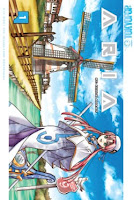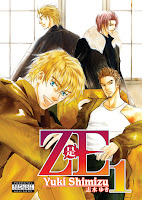My News and Reviews
It is time for the Rumiko Takahashi Manga Moveable Feast! The feast begins today and will end on Sunday. Rob McMonigal at Panel Patter will be hosting. Rob has also been running a spotlight on Takahashi that is worth checking out. There is also a fantastic Takahashi fansite, Rumic World, that has a ton of great information available about Takahashi and her works. As for me, I spent all last week immersing myself in Takahashi manga and anime in order to prepare for the Manga Moveable Feast. So, all of my quick takes feature Takahashi. My manga giveaway for this month (starting on Wednesday) will be the first two volumes of Ranma 1/2. And on Friday, I’ll be posting an in-depth review of the first volume of Mermaid Saga. I’ll should also mention a review that I previously posted for Ranma 1/2, Volume 1: Battle of the Sexes.
As for last week’s posts, I reviewed Eiji Yoshikawa’s epic historical novel Musashi and Isuna Hasekura’s light novel Spice & Wolf, Volume 3. I’m really enjoying the Spice & Wolf series more than I thought I would; I absolutely adore Lawrence and Holo. Musashi is the basis for numerous films as well as Takehiko Inoue’s Vagabond. I promised myself I would read the novel before starting the manga series, and now I have. It’s a very long book, but I enjoyed it quite a bit.
Quick Takes
 InuYasha, Omnibus 1 (equivalent to Volumes 1-3) by Rumiko Takahashi. I’m not sure if it’s because I saw the anime before I read the manga, but I think I actually prefer the anime in this case. Granted, I’ve not read or seen enough of InuYasha to be able to know for sure. This is not to say I didn’t enjoy the manga because I did. It’s certainly not my favorite work by Takahashi, though. Although, some things do make more sense in the manga than they do in the anime. However, the manga feels like it’s rushing from battle to battle without taking time to really develop the characters or story. It reads very, very quickly which is both a good and a bad thing. The yōkai are varied and their fights are entertaining.
InuYasha, Omnibus 1 (equivalent to Volumes 1-3) by Rumiko Takahashi. I’m not sure if it’s because I saw the anime before I read the manga, but I think I actually prefer the anime in this case. Granted, I’ve not read or seen enough of InuYasha to be able to know for sure. This is not to say I didn’t enjoy the manga because I did. It’s certainly not my favorite work by Takahashi, though. Although, some things do make more sense in the manga than they do in the anime. However, the manga feels like it’s rushing from battle to battle without taking time to really develop the characters or story. It reads very, very quickly which is both a good and a bad thing. The yōkai are varied and their fights are entertaining.
 Mermaid Saga, Volumes 1-4 by Rumiko Takahashi. Mermaid Saga is one of Takahashi’s shortest series. It’s also dark, creepy, disconcerting, and utterly fantastic. If you couldn’t tell, I loved it. Eating the flesh of a mermaid potentially grants the gift of immortality, but those who aren’t so lucky die a painful death or are transformed into monstrous “lost souls” from the poison. But even life as an immortal may be more of a curse than a blessing. Yuta has been alive for five hundred years, dying and returning to life dozens of times, and is tired of his lonely existence. As he searches for a way to return to normal he occasionally comes across other immortals, each with their own tragic history. Messing around with life and death never ends well.
Mermaid Saga, Volumes 1-4 by Rumiko Takahashi. Mermaid Saga is one of Takahashi’s shortest series. It’s also dark, creepy, disconcerting, and utterly fantastic. If you couldn’t tell, I loved it. Eating the flesh of a mermaid potentially grants the gift of immortality, but those who aren’t so lucky die a painful death or are transformed into monstrous “lost souls” from the poison. But even life as an immortal may be more of a curse than a blessing. Yuta has been alive for five hundred years, dying and returning to life dozens of times, and is tired of his lonely existence. As he searches for a way to return to normal he occasionally comes across other immortals, each with their own tragic history. Messing around with life and death never ends well.
 Ranma 1/2, Volumes 2-14 by Rumiko Takahashi. Oh, Ranma 1/2, how I adore you. This series is one of the first manga I fell in love with and collected in its entirety. It was also my introduction to Takahashi. Some of the humor is going to be hit and miss simply due to personal preference—I, for one, can barely stand the principal. Still, I am impressed by how long Takahashi can keep the joke going without it feeling too repetitive. Ranma 1/2 is absurd and ridiculous and a tremendous amount of fun. Even though I had previously read the series, I still found it to be amusing. Full of gender swapping, not to mention species swapping, and an abundance of crazy and insane martial arts, I can’t help but love it.
Ranma 1/2, Volumes 2-14 by Rumiko Takahashi. Oh, Ranma 1/2, how I adore you. This series is one of the first manga I fell in love with and collected in its entirety. It was also my introduction to Takahashi. Some of the humor is going to be hit and miss simply due to personal preference—I, for one, can barely stand the principal. Still, I am impressed by how long Takahashi can keep the joke going without it feeling too repetitive. Ranma 1/2 is absurd and ridiculous and a tremendous amount of fun. Even though I had previously read the series, I still found it to be amusing. Full of gender swapping, not to mention species swapping, and an abundance of crazy and insane martial arts, I can’t help but love it.
 InuYasha: Season 1, Episodes 1-19 directed by Masashi Ikeda and Yasunao Aoki. Although I enjoyed the anime from the beginning, initially it felt too episodic to me. But as the series progresses an overarching plot is introduced. This is what I needed to really invest myself in the story. Although I really like the Higurashi family and appreciate when they get some screen time, I greatly prefer the episodes that take place during the Warring States period over those that take place during the modern era. Actually, I like most of the characters—their strong personalities make for some great interactions. While I might not continue reading the manga, I’ll probably be watching more of the anime.
InuYasha: Season 1, Episodes 1-19 directed by Masashi Ikeda and Yasunao Aoki. Although I enjoyed the anime from the beginning, initially it felt too episodic to me. But as the series progresses an overarching plot is introduced. This is what I needed to really invest myself in the story. Although I really like the Higurashi family and appreciate when they get some screen time, I greatly prefer the episodes that take place during the Warring States period over those that take place during the modern era. Actually, I like most of the characters—their strong personalities make for some great interactions. While I might not continue reading the manga, I’ll probably be watching more of the anime.
 Urusei Yatsura, Episodes 1-4 directed by Mamoru Oshii. I don’t even remember when or where I got this DVD, but fortunately the Manga Moveable Feast reminded me that I owned it. It’s really too bad that I took so long to finally watch it, because it has some very funny stuff in it. In fact, I found myself maniacally giggling out loud on several occasions. I’ve only seen these four episodes (out of one hundred ninety five) but I can safely say I would like to see more. It’s a weird and strange story about obnoxious aliens that intend to invade Earth but are stopped when they are defeated in a game of tag by a lecherous high schooler. Some of the aliens stick around and hijinks ensue.
Urusei Yatsura, Episodes 1-4 directed by Mamoru Oshii. I don’t even remember when or where I got this DVD, but fortunately the Manga Moveable Feast reminded me that I owned it. It’s really too bad that I took so long to finally watch it, because it has some very funny stuff in it. In fact, I found myself maniacally giggling out loud on several occasions. I’ve only seen these four episodes (out of one hundred ninety five) but I can safely say I would like to see more. It’s a weird and strange story about obnoxious aliens that intend to invade Earth but are stopped when they are defeated in a game of tag by a lecherous high schooler. Some of the aliens stick around and hijinks ensue.







